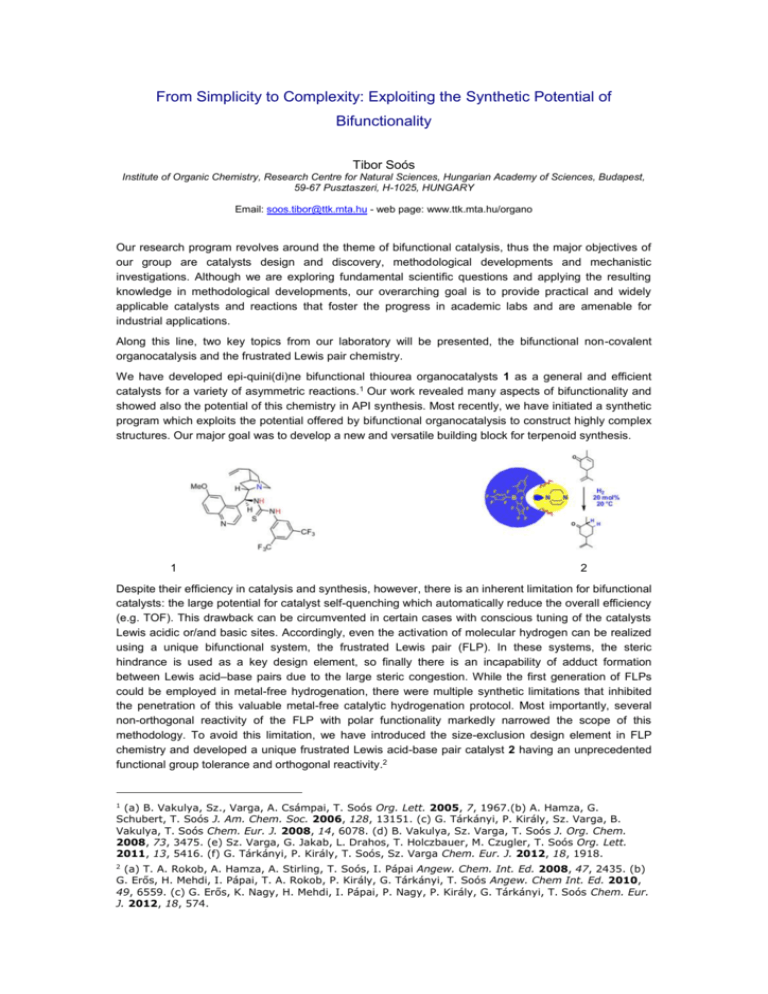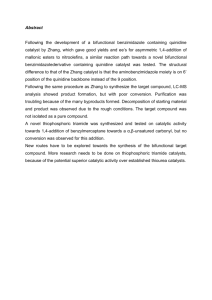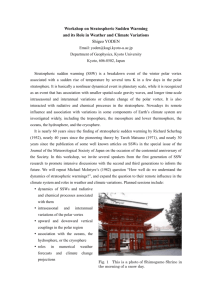From Simplicity to Complexity: Exploiting the Synthetic
advertisement

From Simplicity to Complexity: Exploiting the Synthetic Potential of Bifunctionality Tibor Soós Institute of Organic Chemistry, Research Centre for Natural Sciences, Hungarian Academy of Sciences, Budapest, 59-67 Pusztaszeri, H-1025, HUNGARY Email: soos.tibor@ttk.mta.hu - web page: www.ttk.mta.hu/organo Our research program revolves around the theme of bifunctional catalysis, thus the major objectives of our group are catalysts design and discovery, methodological developments and mechanistic investigations. Although we are exploring fundamental scientific questions and applying the resulting knowledge in methodological developments, our overarching goal is to provide practical and widely applicable catalysts and reactions that foster the progress in academic labs and are amenable for industrial applications. Along this line, two key topics from our laboratory will be presented, the bifunctional non-covalent organocatalysis and the frustrated Lewis pair chemistry. We have developed epi-quini(di)ne bifunctional thiourea organocatalysts 1 as a general and efficient catalysts for a variety of asymmetric reactions.1 Our work revealed many aspects of bifunctionality and showed also the potential of this chemistry in API synthesis. Most recently, we have initiated a synthetic program which exploits the potential offered by bifunctional organocatalysis to construct highly complex structures. Our major goal was to develop a new and versatile building block for terpenoid synthesis. 1 2 Despite their efficiency in catalysis and synthesis, however, there is an inherent limitation for bifunctional catalysts: the large potential for catalyst self-quenching which automatically reduce the overall efficiency (e.g. TOF). This drawback can be circumvented in certain cases with conscious tuning of the catalysts Lewis acidic or/and basic sites. Accordingly, even the activation of molecular hydrogen can be realized using a unique bifunctional system, the frustrated Lewis pair (FLP). In these systems, the steric hindrance is used as a key design element, so finally there is an incapability of adduct formation between Lewis acid–base pairs due to the large steric congestion. While the first generation of FLPs could be employed in metal-free hydrogenation, there were multiple synthetic limitations that inhibited the penetration of this valuable metal-free catalytic hydrogenation protocol. Most importantly, several non-orthogonal reactivity of the FLP with polar functionality markedly narrowed the scope of this methodology. To avoid this limitation, we have introduced the size-exclusion design element in FLP chemistry and developed a unique frustrated Lewis acid-base pair catalyst 2 having an unprecedented functional group tolerance and orthogonal reactivity.2 (a) B. Vakulya, Sz., Varga, A. Csámpai, T. Soós Org. Lett. 2005, 7, 1967.(b) A. Hamza, G. Schubert, T. Soós J. Am. Chem. Soc. 2006, 128, 13151. (c) G. Tárkányi, P. Király, Sz. Varga, B. Vakulya, T. Soós Chem. Eur. J. 2008, 14, 6078. (d) B. Vakulya, Sz. Varga, T. Soós J. Org. Chem. 2008, 73, 3475. (e) Sz. Varga, G. Jakab, L. Drahos, T. Holczbauer, M. Czugler, T. Soós Org. Lett. 2011, 13, 5416. (f) G. Tárkányi, P. Király, T. Soós, Sz. Varga Chem. Eur. J. 2012, 18, 1918. 1 (a) T. A. Rokob, A. Hamza, A. Stirling, T. Soós, I. Pápai Angew. Chem. Int. Ed. 2008, 47, 2435. (b) G. Erős, H. Mehdi, I. Pápai, T. A. Rokob, P. Király, G. Tárkányi, T. Soós Angew. Chem Int. Ed. 2010, 49, 6559. (c) G. Erős, K. Nagy, H. Mehdi, I. Pápai, P. Nagy, P. Király, G. Tárkányi, T. Soós Chem. Eur. J. 2012, 18, 574. 2








